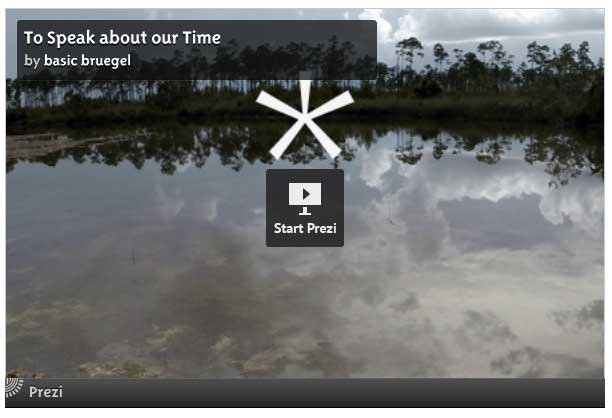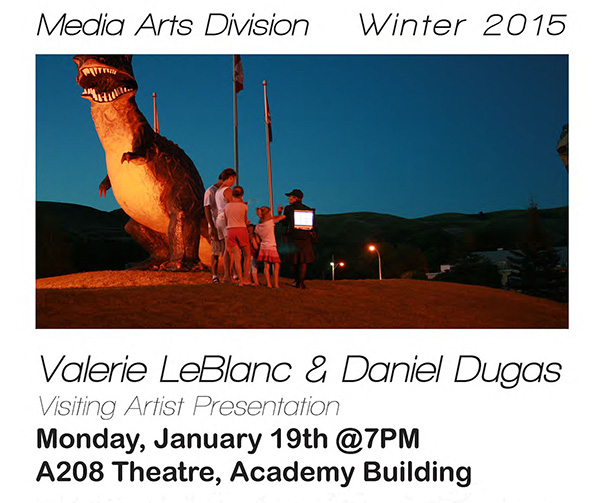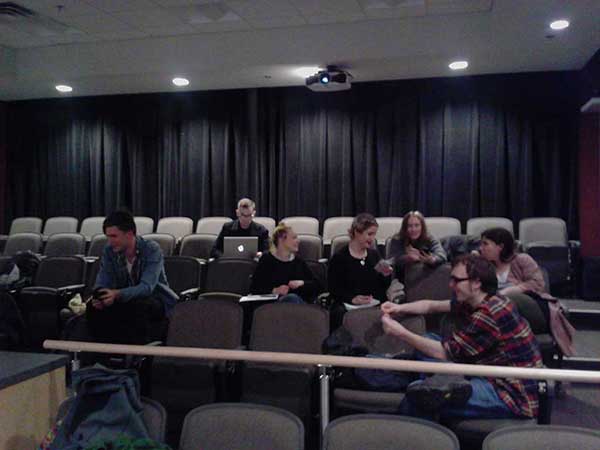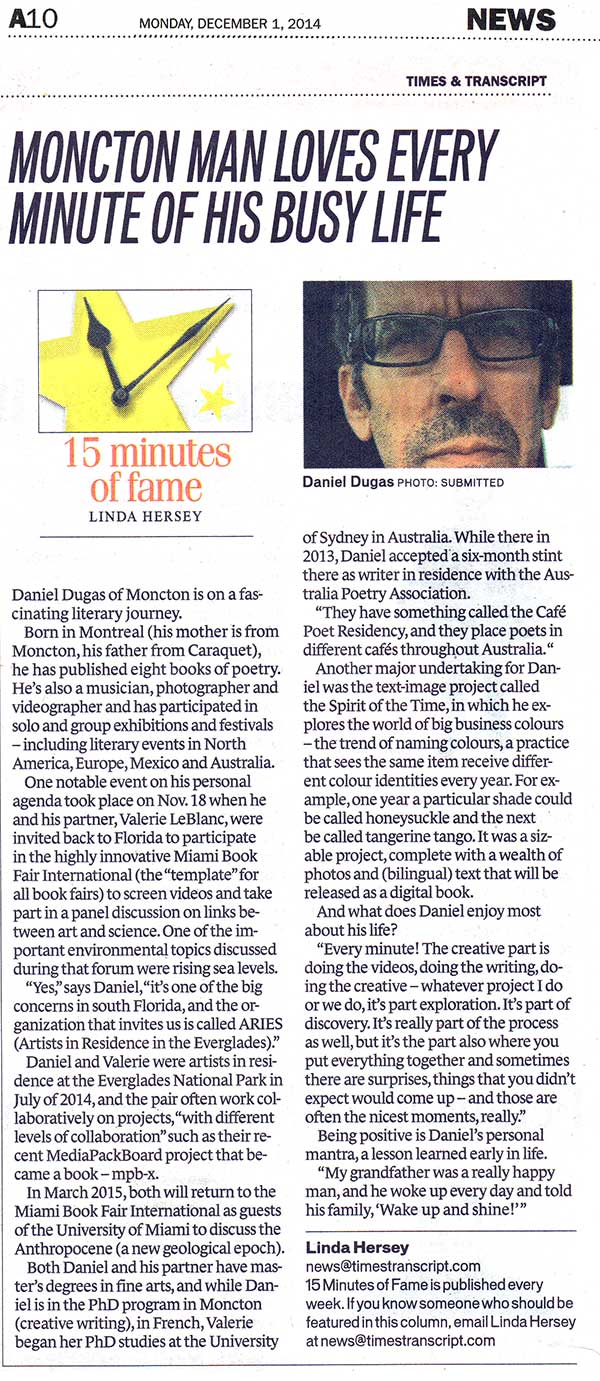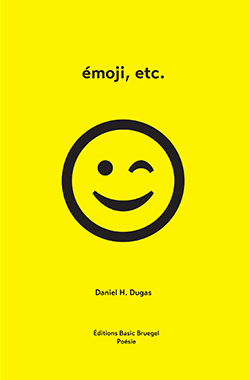To Speak About Our Time (2015)
Transcript of Daniel Dugas’ talk given during the AnthropoScene, a semester-long exploration of this new era sponsored by the Leonard and Jayne Abess Center for Ecosystem Science & Policy and the College of Arts and Sciences of the University of Miami with participation by Artists in Residence in the Everglades.

TOP: The Trinity explosion, July 16, 1945; BELOW: The wolf of Hokkaido, the Tasmanian tiger and the Yangtze River dolphin.
The image of the first explosion of an atomic bomb to represent the beginning of the Anthropocene epoch is a dramatic choice. It is a powerful marker that can also remind us that what starts with a bang could also end with a whimper.
When I was first looking into the terminology for geological time scales, eras, periods and epochs, I was trying to visualize the latter part of the scale. Where are we in there? How do we fit in? What is the correlation between us and the bomb, the bomb and our daily life? If I was to transpose the atomic bomb into a in a more modest span of time, I would think that it would be like starting a new day by getting up on the wrong side of the bed, or worse by getting up only to trip on the carpet at the foot of the bed. The optimist in me says that it would only get better from there.
After taking care of this time scale concept, sort of, I started to worry about the implications of using such an image? What does it mean to have an atomic bomb symbolise the beginning of something? The images of the early blasts are still imprinted in our minds. I can still feel their heat and there is still a part of me that wants to run for cover under a desk or a table. The iconic charge of the bomb is still there and its power continues to frighten us all.
The Oomph Factor
There is a reason for everything. And the reason for choosing the atomic bomb as the icon for this epoch is fine. We all agree that it would have been less persuasive to have used an abstract rendition of a medical isotope. If radiation can be used to heat or to heal, it is also a metaphor for death and destruction, and this brings the atomic bomb, as an icon, much closer to the end of the world than the ‘radioactive substances used by health professionals to assist in the diagnosis and healing of certain health conditions.’ But is this the end of the world? Yes and no. For those who are going to disappear, it is. And we have seen countless of disappearances so far. The wolf of Hokkaido left us in 1889, the Tasmanian tiger in 1936, and the Yangtze River dolphin in 2007, among others. And there will be more species disappear from our world in the future.
Although the image shown suggests that the Anthropocene is the end of the world, it is not. Instead, it is a marker for a state of the world. It demonstrates the farthest we can go, the extreme limit of the human experience. The end of the world has a distance and a time frame attached to it. In the Everglades it was the name that the people living in what is now known as Flamingo thought the place should be called. It was about space. For the estimated between 90,000 – 166,000 people who died in the Hiroshima explosion, it was the end of time.
In 2004 I created the installation Nuclear Mickeys with an audio component entitled 666 seconds of hesitation. The sound track was based upon the Robert Oppenheimer “Now I am Become Death” recording.[1] The Nuclear Mickeys were nuclear explosions that got a fashion makeover for easy and safe consumption. I wanted to show how marketing swallows and dilutes meaning, making everything a game. I was fascinated by the silences and hesitations in Oppenheimer’s speech and based the soundtrack on them. The recording is 58 seconds in length; 28 seconds are comprised of silences, hesitations and breathing. I cut out the words and only kept these pauses. For me, these are the real messages, the heaviest messages.
I would like to draw your attention to this time-lapse map of Japanese artist Isao Hashimoto. It spotlights 2053 nuclear explosions that have taken place between 1945 and 1998.[2]
Alternative Symbol: Implosion vs. Explosion
So, we know the exact time and place of the first atomic bomb: July 16, 1945, at 5:29:45 a.m., Alamogordo, New Mexico. To be exact, the birth of the modern world is the Alamogordo Bombing and Gunnery Range (now known as the White Sands Missile Range), and in an ironic twist, owing to the Atari video game burial of 1983, Alamogordo could also be known as a mass grave of our modern world:
This was…a mass burial of unsold video game cartridges, consoles, and computers undertaken by American video game and home computer company Atari, Inc. in 1983. The goods disposed of through the burial were generally believed to have been unsold copies of E.T. the Extra-Terrestrial, a game which had become one of the biggest commercial failures in video gaming and is often cited as one of the worst video games ever released.[3]
If the bomb is a great source of inspiration and fascination you have to agree that the whole Atari burial thing is quite something as well. And the cherry on the cake goes to the Vice Admiral Blandy, and his wife cutting the Atomic Cake in a 1946 ceremony celebrating the first explosion in a post war era (peacetime). All is a question of perception and attitude.
End of the World Narrative vs. Speed of the World
The great acceleration of human activities that has been happening in the last 60 years has also transformed our perception of the world. But Speed is an interesting word. It means ‘rapidity of movement, quickness, swiftness’, but in old English SPED means ‘success, a successful course; prosperity, riches, wealth; luck; opportunity, advancement.’ [4] We thrive on speed, it is been the foundation of our modern world. And even if everything goes by faster and faster, we believe that everything will be okay. Everything has to be okay for things to go on. And we like things to go on. This message of hope is conveyed in every advertisement, in every slogan: Beyond Petroleum (bp), Make things better (Toyota), Solving Challenges (Halliburton) or Solutions are in our nature (David Suzuki) –all offer visions of optimism and possibilities.
In 2010, we all witnessed the Gulf of Mexico oil spill. For me, it was a watershed moment of great sadness. I was emotionally shaken by what I was seeing. Like many, I stood there powerless, watching the strange image of oil gushing out of a pipe. We were witnessing an endless leak of oil, right in the middle of the so-called Peak Oil period. What followed changed our perception of disaster. I think from that moment, no disaster would be seen the same way.
Two week after the blowout, I listened to the CBC (Canadian Broadcasting Corporation) interview with Dr. Overton, Professor Emeritus at Louisiana State University’s Department of Environmental Science. He spoke of the uncertainty and the scope of the event, noting that it would never be as big as the Exxon Valdez. The doctor talked about the oil spreading over a much longer period of time than the spill from the ill-fated tanker and explained how the effects would be less severe. He went on to compare the situation to a house fire saying that ‘a room might be on fire, but it doesn’t mean that the house is in danger.’ I was shocked to hear something like that. The doctor was actually comparing the oil spill and the Gulf of Mexico to the ‘room’ and the rest of the planet to the ‘house’, talking about the environment as a series of compartments, secluded from one another, with fire doors in between habitats, something like a weekly pill organizer.
And somehow the disaster went away. In mid August President Obama and his daughter Sasha were already swimming for the cameras at Panama City Beach. Normality prevailed.
Less than a year later, on March 11, 2011, we collectively witnessed the Fukushima Daiichi nuclear disaster. The meltdown of three of the plant’s six nuclear reactors was big news for a while, but this too went away. It did not take long for Japan’s Prime Minister, Shinzo Abe, to assure the International Olympic Committee that radiation leaks at the plant were ‘under control’. Eighteen months after the meltdown, the Olympic Committee announced that Tokyo (238 kilometres from Fukushima) would host the 2020 Summer Olympics. And suddenly, rapidly, successfully our planet becomes a house; we can close the Gulf of Mexico door or the Fukushima door and celebrate all that is good in the world. We would like to think that. Unfortunately, last week’s FUKUSHIMA UPDATE revealed that another pool of highly contaminated water was found to be leaking into the sea.[5] According to some, the final clean-up will take 40 years.
The lesson to be learned from both of these disasters is one of attitude and perception. If such disasters can occur so close to us, to them, and everything is fine, then we have to realize that the disasters to come have a serious benchmark to surpass in order to be qualified as worrisome. The earth can take it. She is tough. We’ll close the door or draw the curtains down.
Functions of the artist: Eye witnessing/investigating/reporting/
What can artists do, how can we contribute? Much like the artists sent on explorers’ ships, we can draw or take photographs of what we are seeing as a legacy for the future. Our function will be to document what is out there, but more importantly, we can keep the door open and make sure that the curtain stays up. Wassily Kandinsky said that artists have a responsibility to speak about their time, to speak about the spirit of their age. To paraphrase Roy – the leader of the renegade Nexus-6 Replicants in the movie Blade Runner, I will add that not speaking about our time here, would be like losing tears in the rain. If we take responsibly for something, we acknowledge that we can do something, and to forfeit this opportunity is like losing tears in the rain.
Daniel Dugas
March 4, 2015
University of Miami, FL
__________________________________________________________________
[1] Now I am become Death, the destroyer of worlds
“We knew the world would not be the same. Few people laughed, few people cried, most people were silent. I remembered the line from the Hindu scripture, the Bhagavad-Gita. Vishnu is trying to persuade the Prince that he should do his duty and to impress him takes on his multi-armed form and says, ‘Now I am become Death, the destroyer of worlds.’ I suppose we all thought that, one way or another.” Interview with J. Robert Oppenheimer about the Trinity explosion, first broadcast as part of the television documentary The Decision to Drop the Bomb (1965), produced by Fred Freed, NBC White Paper. https://www.youtube.com/watch?v=_LmxIptS3cw
[2] A Time-Lapse Map of Every Nuclear Explosion Since 1945 by Isao Hashimoto, 2003
About “1945-1998″ “This piece of work is a bird’s eye view of the history by scaling down a month length of time into one second. No letter is used for equal messaging to all viewers without language barrier. The blinking light, sound and the numbers on the world map show when, where and how many experiments each country have conducted. I created this work for the means of an interface to the people who are yet to know of the extremely grave, but present problem of the world.” http://www.ctbto.org/specials/1945-1998-by-isao-hashimoto/
[3] Atari video game burial
http://en.wikipedia.org/wiki/Atari_video_game_burial
[4] SPEED: Old English sped “success, a successful course; prosperity, riches, wealth; luck; opportunity, advancement,” from Proto-Germanic *spodiz (cognates: Old Saxon spod “success,” Dutch spoed “haste, speed,” Old High German spuot “success,” Old Saxon spodian “to cause to succeed,” Middle Dutch spoeden, Old High German spuoten “to haste”), from PIE *spo-ti-, from root *spe- (1) “to thrive, prosper” (cognates: Sanskrit sphayate “increases,” Latin sperare “to hope,” Old Church Slavonic spechu “endeavor,” Lithuanian speju “to have leisure”).
Meaning “rapidity of movement, quickness, swiftness” emerged in late Old English (at first usually adverbially, in dative plural, as in spedum feran). Meaning “rate of motion or progress” (whether fast or slow) is from c.1200. Meaning “gear of a machine” is attested from 1866. Meaning “methamphetamine, or a related drug,” first attested 1967, from its effect on users.
http://www.etymonline.com/index.php?term=speed&allowed_in_frame=0
[5] Fukushima Update nuclear news from japan
FukushimaUpdate.com went online on October 16, 2011. It is dedicated to providing news and information related to the nuclear crisis at the Fukushima Daiichi nuclear power plant in northeastern Japan. With neither a pro- nor anti-nuclear agenda and no axes to grind, Fukushima Update aims to be a one-stop source for reliable, fact-based reporting about the Fukushima situation.
Link to Valerie LeBlanc’s talk
Text(e) Image Beat opening! (2015)
Le vernissage de Text(e) Image Beat aura lieu le 20 mars 2015 à la Galerie Sans Nom!
The opening of Text(e) Image Beat will be held on March 20 at the Galerie Sans Nom!
With: Heid E. Erdrich, Hannah Black, Matt Mullins, Martha Cooley, John D. Scott, Tom Konyves, Swoon (AKA Marc Neys), Michel Félix Lemieux, Kevin Barrington, Maryse Arseneault, Fernando Lazzari and Matthew Hayes.
La version française sera bientôt disponible
Curators’ Commentary
Valerie LeBlanc and Daniel H. Dugas
Video poetry is a genre that is increasingly drawing the attention of both audiences and creators. We have come a long way since moving pictures with sound required a vast and expensive array of infrastructure and personnel. We are also in a time when the visual vocabulary and knowledge of signifiers is more familiar to wider audiences. This should not come as too great a surprise when we think that what is considered to be the first documented photograph was made close to 200 years ago[1] and that moving picture techniques pioneered in the early 20th century resulted in the first feature film with sound,The Jazz Singer in1927. While photography, moving pictures, and recorded sound / music were first thought to hold value for documentary applications only, the use of these tools are constantly transforming our concepts of art. Through time-based media, ideas move into the thought process; visceral effects are imprinted.
Creators are now presenting their texts visually and / or performing their poems. Many have realized that messages can be effectively conveyed using the multimodal character of video poetry. Similarly to advertisements created for marketing campaigns, these works are characteristically short, less than 5 minutes in duration. Some festivals are asking for works as short as one minute, the duration of some TV ads. The videos in this program have been chosen for their content as well as for the techniques that each creator uses to portray the meaning and aesthetic sense of the content.
The call for Text(e) / Image / Beat did not specify particular themes. Through the necessity of paring down the choices and assembling a flow of works that complemented and gave space to each other, we became aware of recurrent elements. In spite of the fact that the videos originate from many distinct locations, ideas of awaiting / finding miracles and mysteries of living, are frequent. Each work exhibits innovation and imagination, calling upon a wide range of skills to layer meaning. Slam poetry, rants, softly spoken words, hand written notes, and remixes are all used to articulate.
In Pre-Occupied, texts over images; multi-layering stereotypical references from popular culture and memes relating to current and past events carry Heid E. Erdrich’s words like a fast moving river. References to the first American Thanksgiving, Alcatraz, Wounded Knee, Indigenous activists; key words and statements are thrown; fonts are visually woven with voice intonation to deliver meaning. The video opens with an excerpt from Langston Hughes’ The Negro Speaks of Rivers: ‘I’ve known rivers: Ancient, dusky rivers. My soul has grown deep like the rivers.’ Erdrich states the title: Pre-Occupied and then begins her powerful litany, ‘River, River, River, I Never, Never, Never etched your spiral icon in limestone …’. Hughes words continue under Erdrich’s. The dynamics of the lead-in continue through to the end. Closing credits are accompanied with an Anishinaabemowin (Ojibwe) translation of John Lennon’s Imagine. Pre-Occupied hits chords of dreams for political and social equality: held, dashed, revisited and restated.
A series of spirals are drawn over the neck in the opening scenes of Hannah Black’s video of the same name. Through calling attention to the limitations of her childhood drawings, Black brings a discussion of identity. With her own body as the starting point, she steers her words toward ‘… an improbable form of mediation between a self and its constituent parts: family, body, race, gender, …’ Essentially, her video addresses the whole world and its concerns as she draws the personal into the political arena.
In Our Bodies, Matt Mullins remixes a sermon by televangelist Oral Roberts, cutting away excess material, repeating words and phrases, using split screens, and setting inserts to emphasize specific gestures. Mullins closes the videopoem with an excerpt from a sinners’ prayer, ‘… I am ready to perform a miracle in your life … expect delivery.’ As Oral Roberts interprets the Bible, Matt Mullins, in turn interprets Oral Roberts.[2]
Martha Cooley’s Dog Sitting in Eastern Passage uses a combination of devices. While handwritten pages from a notebook bring her thoughts to life, the pages are set within sequences of photos to create movement. Thrown by a heartbroken author, a dog fetches sticks along the Atlantic coastline. Through the work we are reminded of that basic miracle of video and film media, the persistence of vision that brings us the illusion of movement.
John D. Scott breathes life into Elizabeth Bishop’s 1965 poem Sandpiper. He interprets that Bishop anthropomorphizes into the bird. While sandpipers are known to flit persistently on beaches, her life as a revered writer of short stories and poetry was also one of searches, observations, of taking many directions. A haunting whistle, a rattle and clicks of the typewriter open the video and continue to underline the spoken word. Scott’s collaboration includes rotoscoped bird images by Anna Bron and Andrew Whyte, stills and slow moving images of water and beach. Particular passages are emphasized and punctuated through movement and voice.
Having coined ‘videopoetry’ in 1978, Tom Konyves is recognized as one of the pioneers of the genre. In his video ow (n) ed, politically charged meanings are layered and set into a crypted triptych that he describes as a postmodern vision of human slavery. Punctuated by jazz notes, Konyves has positioned quotes from American Slavery As It Is: Testimony of a Thousand Witnesses[3] on the left. In the center, a tower of humans is constructed and collapses.[4] Consumer commentaries play on the right. As the video progresses, messages on the left spill over, slipping to the right. Through erasure (dropping regions of the text and remixing), Konyves is implying new meanings.
Well known for remix, collaborations and atmospheric compositions, Marc Neys (aka SWOON) has supplied the concept, editing, and music in the creation of Five Miles (Simple Brushstrokes on a Naked Canvas). Howie Good has contributed the poem. Excerpts from the 1944 American Military documentary Target for Today, speak about possible bombing but no bodies are seen. Throughout the video an ominous voice repeats ‘five miles.’ Instead of increasing or decreasing the distance to the target, we are forced to hover in abstraction. A slow moving, amorphous bubble suddenly appears. As it floats over green grass the text ‘because a feeling has no form’ is spelled out. In the bellicose tone set by the video, this colorful bubble carries a menacing hint of possible outcomes.
Michel Félix Lemieux’s Brûle le bois vert takes us on a train ride at night. A moving spotlight illuminates the view through a square window. Lemieux describes this work as a poetic and confused reflection on exodus. While we are almost deprived of images in the video, the text is loaded with saturated colors. The words contaminate what we are seeing. In a poem that offers glimpses of mental and emotional moods over any coherent flow of thought, an awareness of solitude pervades.
Kevin Barrington’s I Love the Internet is a skillful fast rant by this Dublin based copywriter and blogger. A collaborative project with Irish animation artist and illustrator Bruce Ryder, the poem advances through use of psychedelic colors and a text matte over quick moving images. The video derives from Barrington’s multi-media e-book of the same name. Barrington states, ‘The impulse was to repel a rising wave of establishment antipathy to social media expression that took hold early in 2013 and threatened to silence satire and online political heckling.’
In constructing Retenir son souffle, Maryse Arsenault used French and English to deliver her texts; a speaking and singing voice; images and sound shot in her own environment; and found footage of a weather phenomenon. The voice, which we understand as Maryse, asks for help. It is the voice that we sometimes need to hear when we are hoping for a miracle. The video ends with sounds of whistling and a bell like that of a life buoy. A small bird goes out and returns 3 times; the repetition works like an incantation in the closing of this lullaby.
Montserrat follows Retenir son souffle in the program. These two very different videopoems explore threads of holding up the world through dark times. To relate an excerpt of Jorge Luis Borges’ Amanecer (Break of Day), Fernando Lazzari uses ‘font as character’. Borges’ poem speaks of a world held together by the imagination of those who inhabit the night, until the day returns and others awake to define its shape with their presence. At times, images move rapidly; sometimes they hover to become imprinted as font generation builds monuments to the words.
Slam Poet Sasha Patterson performs her poem Tonight is for the Trees; cinematography and editing is by Matthew Hayes, with music by Lee Rosevere. Patterson walks out of the darkness along a tree-lined road. At first lit by only a flashlight, she is suddenly in full light and continues to address her audience as she walks toward the camera. The effect is simple and effective. Tonight is for the Trees brings reminders of Christopher Dewdney’s August as both poems celebrate summer and life in southern Ontario.[5] Each passage of Dewdney’s list: nature’s creatures and the beauty of geological formations begins with ‘because’. Patterson repeats ‘ tonight is for …’ before each new item in her long list of dedications. Links between the two works are not literal but meet in sentiment, intention and appreciation for life, nature and the human presence in it all. Patterson’s fresh and confident voice epitomizes hope.
While Pre-Occupied dropped us into the middle of all things worldly and imagined, Tonight is for the Trees brings closing notes to Image / Text(e) / Beat. In the long history of the known and unknown, the visible and the invisible, the spoken and the unspoken, video poetry sets the prompts, the magic of visions hinted by the words, images and sounds. Rhythm set by videopoetry widens the chances of getting messages out. We hope that a tradition of video poetry will come to be established in Moncton. With the number of poets per capita, it seems to be a viable, and maybe inevitable prospect.
[1] The First Photograph, Harry Ransom Center, University of Texas at Austin:http://www.hrc.utexas.edu/exhibitions/permanent/firstphotograph/
Nicéphore Niépce, Wikipedia: http://en.wikipedia.org/wiki/Nicéphore_Niépce
[2] To appreciate the effectiveness of Mullins’ remix, check out The Hand of God, from Oral Roberts Crusade, St. Petersburg, FL (1964) on You Tube:https://www.youtube.com/watch?v=rGi_vRS9zH8
[3] Theodore Dwight Weld, 1803-1895, ‘American Slavery As It Is: Testimony of a Thousand Witnesses’: http://docsouth.unc.edu/neh/weld/summary.html
[4] In 2010, castells of Catalonia were declared by UNESCO to be amongst the Masterpieces of the Oral and Intangible Heritage of Humanity: http://www.unesco.org/culture/ich/index.php?lg=en&pg=00011&RL=00364
[5] Christopher Dewdney, August, Poetry In Motion (1982), YouTube:https://www.youtube.com/watch?v=CN3AaYp_kyY
AnthropoScene workshop (2015)
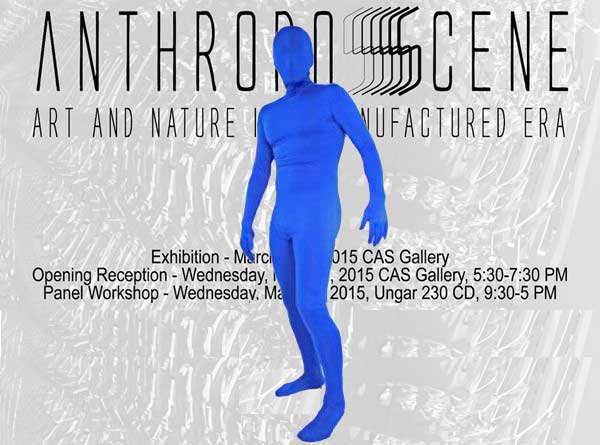
AnthropoScene – color keying workshop
Valerie LeBlanc and Daniel Dugas, University of Miami, FL – March 2015
MOVING IN THE LANDSCAPE: VISIBLE / INVISIBLE
This exercise in visual composition offers opportunities to discuss evidence of human passage in the natural landscape. During the editing process, each person will have access to the workshop footage. This will enable Students to further collaborate on the end result, or to compose individual works. Through voiceover, text over, and added music or sound compositions, the finished works will potentially convey a variety of messages related to the AnthropoScene Conference objectives.
The group will set up a tripod and camera in a fixed position facing a lush green area. (1) An establishing view of the scene will be recorded. (2) Volunteer(s) wearing the blue or white suit(s) will stand still in the green area. Once an image of the person(s) is recorded, recording will continue and the person(s) will move out of position. Volunteers will be encouraged to try out various ways of moving slowly through the scene.
In the editing process, the footage will be layered and color keying will be used to minimize the visibility of the figure(s). The desired effect in this DIY exercise will be an imperfect removal of the figure. (i.e. the keying effect sometimes leaves edge traces and this will reveal the movement of the figure.) Overall, the finished footage should reveal the outline of a (nearly invisible) figure moving in the landscape. During the editing process, Students will make decisions on what the final work will actually convey to the viewer.
AnthropoScene Schedule (2015)
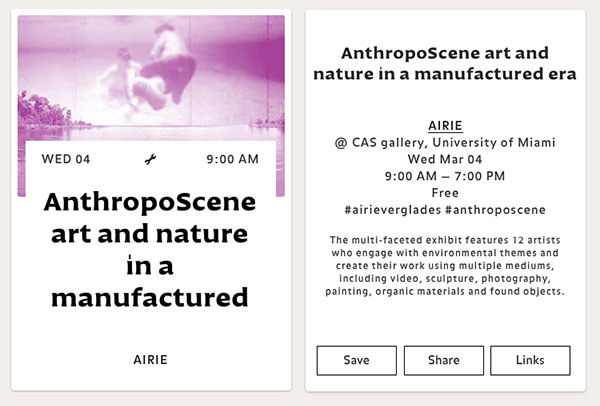
Exhibition March 4 – 24
CAS Gallery. 1210 Stanford Drive. Coral Gables, FL
Panel Discussion March 4 9am-12pm
Ungar Building 230 C/D. 1365 Memorial Drive
Lunch/Gallery Tour March 4 12:30-1:30 pm
CAS Gallery. 1210 Stanford Drive. Coral Gables, FL
Workshops March 4 2-5 pm
CAS Gallery. 1210 Stanford Drive. Coral Gables, FL
Opening Reception March 4 5:30-7:30 pm
CAS Gallery. 1210 Stanford Drive. Coral Gables, FL
SCHEDULE OF EVENTS
MARCH 4
PANEL DISCUSSION
UNGAR 230 C/D. 1365 MEMORIAL DRIVE. CORAL GABLES. FL
with artists
Daniel Dugas
Felice Grodin
Valerie LeBlanc
Lucinda Linderman
Deborah Mitchell
Skip Snow
Keith Waddington
8:30 am – 9:00 am Registration/Coffee Service
9:00 am – 9:15 am Welcome and plan for day: Gina Maranto and Keith Waddington
9:15-9:45 am Opening remarks: Skip Snow
9:45-10:00 Keith Waddington
10:00-10:30 Valerie LeBlanc and Daniel Dugas
10:30-10:45 Skip Snow
10:45-11:00 Break
11:00-11:30 Deborah Mitchell
11:30-12:00 Discussion with all artists moderated by Felice Grodin and Lucinda Linderman
WORKSHOPS AND EXHIBITION OPENING
CAS GALLERY. 1210 STANFORD DRIVE. CORAL GABLES. FL
with artists
Daniel Dugas
Felice Grodin
Valerie LeBlanc
Lucinda Linderman
Susan Silas
Skip Snow
Keith Waddington
12:30 pm – 1:30 pm Buffet Lunch and Tour
(Tour at 1 p.m.)
2:00 pm – 5:00 pm Concurrent workshop sessions
5:30 pm – 7:30 pm Opening reception: anthropoScene exhibition
anthropoScene is a semester-long exploration of this new era sponsored by the Leonard and Jayne Abess Center for Ecosystem Science & Policy and the College of Arts and Sciences of the University of Miami with participation by Artists in Residence in the Everglades.
Subtropics XXIII (2015)
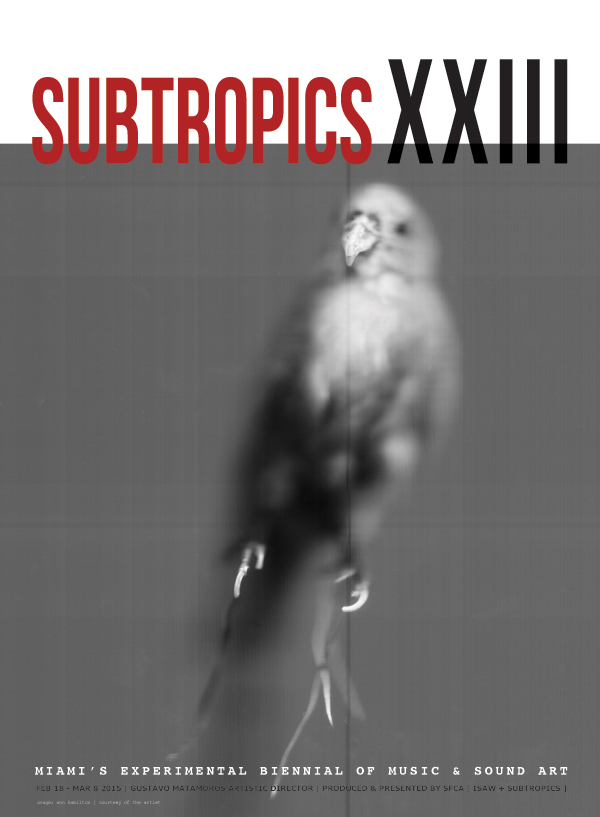
Very excited to be part of this!
SUBTROPICS XXIII
SUBTROPICS XXIII MARATHON
SAT MAR 7 | 3PM (until it ends)
audiotheque marathon concert
924 lincoln road studio 201, miami beach
SUBTROPICS XXIII MARATHON
featuring AISLINN QUINN + BLACKSHIFTRED | ARMANDO RODRIGUEZ | CHEN-HUI JEN | DAN DICKINSON | DANIEL DUGAS + VALERIE LeBLANC | DAVID BRISKE | EDWARD BOBB + THE INERTIALS | ERIC GOTTLIEB | JACOB SUDOL | JORGE GOMEZ ABRANTE | KERRY WARE | LADONNA SMITH | LAWRENCE MOORE | LIZA SEIGIDO | PAULA MATTHUSEN | RENE BARGE | RANDY NUTT | ROBERT BLATT | and more …
SAT MAR 7 | 3PM (until it ends)
http://subtropics.org/2014/10/02/subtropics-xxiii-marathon/
Space at AUDIOTHEQUE is limited, please RSVP through Facebook
NSCAD TALKS (2015)
Transcripts of presentations given during Michael McCormack’s Class ‘The Ready Made Institution’ – Monday, Jan 19, 2015 at the A208 Theatre, Academy Building, Halifax, NS
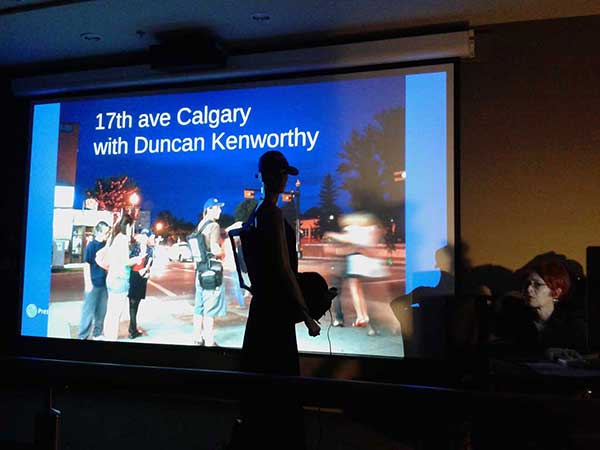
Invisible / Visible
Valerie LeBlanc
Thank you all for being here this evening. We would like to thank the Media Arts Division of NSCAD University, Bruce Barber and Michael McCormack for inviting us today in the context of The Readymade Institution: Portable and Alternative Galleries. Special thanks to: Sarah Hicken, Enterprise Car Rental, Amanda Fauteux and Joanne Reynolds-Farmer, NSCAD.
In trying to define the broader category of what I do as an artist, working with the invisible and the visible probably covers it.
We are here to talk about the MediaPackBoard (MPB) but it is not all of what we do and we will talk about our current and ongoing collaboration: FLOW: BIG WATERS, Everglades project at the end of this presentation.
Amid other life activities and use of various artists’ media, I have been working with video for a long time. During my Foundation studies at NSCAD, Pat Kelly, one of my Instructors, had us work through a video exercise of ‘filling the screen.’ When I created MPB Was There Then, I was remembering back to what I hold in memory as the ‘heyday of conceptual art – when Andy Warhol was GOD’ – and I enjoyed reaching back to the ideas surrounding the image within an image otherwise known as the Droste effect.
And so, as I talk, I will move slightly back and forward in time. Although the MPB has been set up on a mannequin today, it is not yet purely a museum object as yet. Ten years of programming has included not only the playback of new works but active involvement with random audience/participants.
The MediaPackBoard had its public debut at NSCAD during Daniel’s Free Market Karaoke presentation (2005), in the Boardroom. Daniel presented and I tagged along, trying out the MPB on the trip. We also brought along and screened the Alberta Prairie Tales 7 film and video program.
A lot has already been said about the MPB so when I looked at points to bring today, I could not decide what to add to the discourse. Then I realized that which we must always remind ourselves of: THE NOW. I never brought anything HERE to YOU before, and then I got over my block.
The value of creation is commodifiable. It starts out with an idea, moves through a process and finds a place in the world. Some might say that the value of that creative power is known to the artist, and its aggregate value is arrived at when-and-after a work is taken out to the test market. Others might argue for the time factor, the process of permitting the creation to age like a fine wine or cheese. Meanwhile from the creation point of view, back at the studio, if the ideas do not get out, artists can become discouraged with working through all of the processes involved with problem solving; i.e. the how and the why that are needed to create a work, to complete a project.
I think that not getting the work ‘out’ might be what has happened when artists give up creating and move away from the art world. Arguably, it could be the result of individuals deciding that they will apply the problem solving skills honed in the art process to another field with more immediate payback.
Because it can sometimes take a while for the world to catch up with the wonder of your creations, you might be considering the portable gallery option; of taking ideas out to find the audience that is ready for what you can bring to them. And that relates to cultural change, to expanding the parameters and expectations of works that are not of the same stuff as those commodities previously recognized as having value.
In fact, value itself is undergoing new definitions in contemporary culture. While monetary value is still the bottom line, artists are finding that there is interest in their works that fall outside of the lines imposed by traditional gallery structures.
MPB Earth was a hands on science experiment: The Angle of Incidence is Equal to the Angle of Reflection, Calgary, 2008. A spy-cam was attached to a helium balloon. Audience / Participants could direct the gaze of the camera using a mirror and by adjusting the ‘kite strings’. The image picked up by the eye of the camera was projected onto the MPB monitor.
Swedish Director Roy Anderson, in the fortuneteller scene, Songs from the Second Floor, offers a poignant and rather timeless look at the demands of world based politics and economies. There can be multiple interpretations of any movie scene and here is one: Those in charge of the economy and future survival are assembled around a boardroom table in the presence of a fortuneteller. Suddenly, they all notice that the building next door is moving, panicking, they rush out of the room; they bail out. The fortuneteller calmly steps away from her crystal ball, moving slowly toward the window and the shifting view. We could interpret that those gathered around the table were not comfortable with the idea of change, of shifting baselines. Conversely, we could think that the fortuneteller, if a gypsy, or an immigrant was used to embracing change, and the need to move. Staying anchored while moving, changing, growing, maybe that has always been the challenge of living, and of working in the arts.
In the face of events well covered in the media, it seems that going anywhere is becoming more and more difficult. I am imagining that each of you who is taking Michael’s course, has ideas for putting your work out there, for finding your audience, and having your ideas gain more visibility. Within that line of thought, we must all ask ourselves, ‘what is the place of portable and alternative galleries / public performances in today’s world culture?’. This was a question that needed to be addressed in 2005 when first stepping out with the MediaPackBoard. For sure, it is more pressing now.
I had moved into a twin tower in Calgary’s downtown core in the fall of 2000. Taking a camera out on the street changed immediately after 911. ‘I’ as the ‘eye’ behind the camera became a more self-conscious act. After that, the ease or lack of ease and comfort level at both ends of the lens vacillated, as everyone had to become alternately more comfortable and / or more vigilant of recorded scenes.
The 28th G8 Summit was held in Kananaskis, Alberta, June 26-27, 2002.
Living in full view of the Rockies, I saw the military training exercises and other preparations carried out in advance of that world event. Aside from news coverage, I witnessed the comings and goings, and the hovering of military helicopters. It was reminiscent of DirectorJohn Badham’s 1983 Blue Thunder, a movie that pre-told the future of today’s surveillance monitoring.
On Sunday June 23rd, I stepped out to gather some city scenes for the video I was working on. Downtown Calgary on Sundays, at that time, could be pretty quiet. In fact, the streets were deserted and that was no surprise. On that day however, I crossed the street and a police car sped out from around the block, screamed toward me and stopped in the middle of the crosswalk. As I spoke with the driver, answering questions of who I was and where I was going with the camera, the co-pilot searched through the onboard computer. And that was new for me as a videographer. Later, I thought about it and realized that by way of completing an exercise in readiness, anyone with a camera would probably have been stopped on that day. At the time, as a video artist out with a consumer grade camera, it was a first. And so it continues; after each destructive incident, there is some softening of acceptance followed by more stringent agendas. We have to be careful not only to react but to also move proactively in the landscape. It can be a somewhat difficult task.
The idea of creating a portable gallery or a device to get out and work with public audiences relates to transforming creative energies to satisfy the instinct to be visible, for our work to be seen, experienced, and eventually judged by an expanded peer group. While the actual street level meeting might not last longer than the face-to-face encounter, there is the chance that those people who become involved an whatever level they desire will be affected by the experience, and somehow changed. At the very least, the happening has a chance of standing out in memory more than the flow of daily routines. Or as otherwise stated by Nicolas Bourriaud in his 1998 Relational Aesthetics, “It seems more pressing to invent possible relations with our neighbors in the present than to bet on happier tomorrows.”[1]
The MPB was put together to embrace the adventure of showing up to perform unexpectedly, sometimes within another event, and to screen works. While performing and inviting audience participation, being able to screen works was an immediate payback. Sometimes people hung around or followed the MPB carrier to experience the videos. MPB CURATES 2007 involved screening the work of artists: Amalie Atkins, Terry Billings, Linda Rae Dornan, Jim Goertz and Jeffrey John Jackson. The works were screened on the streets, on four separate occasions in Calgary, Edmonton and Drumheller, Alberta, with Guest Carriers interacting with public audiences.
In 2012, Daniel and I brought the MPB Street / Screen Encounter to Eyelevel Gallery’s World Portable Gallery Convention here in Halifax. At that time, Michael was the Director of Eye Level. For that adventure, we went fishing, offering others the chance to direct the gaze of a spy-cam. That was when we first met Michael and started to exchange ideas on portables.
The MPB Curates 2007 booklet was published in (2008) and in 2014, the MPB-X – a critical discourse surrounding ideas of portability in art and art dissemination was launched to celebrate 10 years of MPB. It is available free online. Essays are by: Michael McCormack, Renato Vitic, Daniel H Dugas and Valerie LeBlanc, with a foreword by Diana Sherlock.
MPB-X
MPB History
MPB CURATES 2007
I would like to pass along a few thoughts for consideration in setting out to create a portable and / or alternative gallery:
• Keep it simple. This seems to become easier with each technological breakthrough that becomes accessible to artists as consumers.
• Use mass media tools to give your audience more than they get through mass media.
• Treat your audience on an equal level. Exercises in frustrating an already over traumatized audience should be thrown out, maintain an attitude of offering your projects in the spirit of playful generosity.
• Keep in mind that some work is more complex and cannot be seen on the street.
• Be as clear as possible of what you hope to accomplish through your portable and alternative presentations – and be ready to address all of the questions.
Valerie LeBlanc
Halifax, Jan 19, 2014
[1]Bourriaud, Nicolas, Relational Aesthetics (Dijon: Les presses du reel, 2002), 45. Translated by Simon Pleasance & Fronza Woods with the participation of Mathieu Copeland.
Existing, Being Seen and Taking Risks
Daniel H Dugas
The need to show your work, of setting up structures, of going out there and creating something new is a very dangerous thing to do, whether it is a gallery in a car, in a coat, in a fridge, in a wall, in a pocket, even a wallet; independence means that there is no safety net. It means that you are on your own, that there are no curatorial teams, no museum funding, that there might not be anybody to back you up. But in this loneliness, you are not alone. On your side, you have energy and History. Energy obviously, but History as well, the History of Art to be more precise. Art history is one of the contexts in which your work is situated and whether you embrace this History of Art or you challenge it, it is one of the foundations for what you are doing. Context is a device of imagination.
People say that everything has been done, that there is nothing new under the sky. Nothing could be more false. Anything in our present, anything in our future has never been done. The conditions are always evolving making our NOW unique. There is freshness in everything if you are ready to explore it.
Weegee a New York based photographer and photojournalist, known for his black and white street photography said this, and I think it speaks to one approach, one attitude towards life and people that might relate to the mobile gallery entrepreneurs. He says:
“Here’s my formula – dealing as I do with human beings, and I find them wonderful: I leave them alone and let them be themselves – holding hands with love-light in their eyes – sleeping – or merely walking down the street. The trick is to be where the people are. One doesn’t need a scenario or shooting script, all one needs to do is to be on the spot, alert and human. One never knows what will happen…. I am often asked what kind of Candid Camera I use – there really is no such thing – it’s the photographer who must be candid.”
So, after completing our MFA’s in Chicago, and working in Alberta, we moved back to the Maritimes. We had been away for 7 years and somehow found ourselves with no place to show. Instead of waiting out that long period of time between the application and the opening night, we created our own art centre in the trunk of our 1981 Chevrolet Citation. It was a beautiful car, an RCMP blue hatchback. It had everything going for it. The reaction was immediately positive. People liked it.
I remember the first time we drove in town with our sign; taxi drivers seemed to think that we were another taxi company arriving in town to compete. They looked puzzled. Our slogan was ‘exhibiting near you / expositions près de chez vous.’ We took a chance and we felt empowered.
Newpapers and television stations started to talk about the project. In just a few months, we were talking to Peter Gzowski on CBC radio. We started to get emails from people as far away as BC, invitations us to show up at their place.
Sister Annie Forest, who was 90 at the time, called us to ask if she could show her paintings in the trunk! She had studied at OCAD in the 1940’s. We said yes, booking her for an early summer show. She was doing paintings of the cosmos at the time and the idea of having a galaxy in the trunk was really nice. Unfortunately we had to close the TRUNK in March. After a series of storms, it all became too difficult.
The gallery came back to life in 1999 with Gold / Rush. We travelled to Saint John’s, Newfoundland and to Hamilton, Ontario offering a series of presentations that summer.
There was a third and final TRUNK when the Alberta College of Art + Design celebrated its 75th anniversary. TRUNK75 was a festival of trunks in the College’s parkade. It took place on September 29 and 30th, 2001. There was a lot of planning for the event over the summer months that dissolved or became reshaped. In those times that followed so closely to the events of 911, something strange floated above us all.
Our next mobile project was in 2002. It was a roaming wireless webcam expedition called Location Location Location: We are getting closer.
This project was part of the E-lounge presentations at the Atlantic Cultural Space in Moncton and EMMEDIA in Calgary. We travelled across the country, starting in Calgary. We then stopped down in Winnipeg, Ottawa and Moncton to ask people about cultural characteristics and the benefits of living in their particular urban locations. The interviews were streamed to all the touchdown locations. In 2002 the technology was definitely more cumbersome than it is today. The portable was a lot more difficult to manage. The rapport that most people had with technology then was very different than it is now.
A few years later, in 2005, Valerie launched the MPB: a screen on a backpack; a mobile screen to take into crowds; an artist going for a walk; a world mediated. But this world has changed immensely since 2005. We were, and are more and more living in a world of screens. They surround us; cameras are pointing in every direction.
Although the first smartphone (IBM Simon Personal Communicator – 1993 cell phone with a touchscreen) existed before the iPhone, it was the launch of the first iPhone on June 29, 2007 that changed everything. Developments are so rapid that we have hard time keeping up with the changes. For example, when we did the MPB WPGC in 2012, we used a bamboo stick to extend the reach of the camera, to view the world but also ourselves. That same stick is no longer known as a bamboo stick, it is known as a ‘Selfie Stick’. The BBC had an interesting post on the advent of the tool and pointed out that the first selfie stick might be 90 years old!
When Valerie asked me to write something about the MPB for MPB-X project, I was interested in doing something on the Modes of Operation.
• The first mode is about Participation
It is about going out there and asking people to participate in something. A good example of that is the MPB EARTH. For the occasion, the MPB was linked to a weather balloon filled with helium. A small camera attached near the base of the balloon transmitted a continuous live feed of its point of view to the backpack monitor. Using a mirror and strings the participants were able to direct the eye of the camera to pick up what they wanted.
• The second mode is about Exploration
These projects are often part of a process resulting in the production of photographs, videos and/or texts. MPB End of Signal, was an attempt to access over-the-air TV broadcast signals before digital conversion was imposed by the CRTC. The experiments were carried out in Sackville, New Brunswick and Peggy’s Cove, Nova Scotia. The old Trans-Canada Highway in Sackville provided better reception than in our home in Moncton, even with a homemade antenna.
• The third mode is about Diffusion
This is probably the most evident mode of operation for the MPB. The apparatus is an obvious platform for screening works and was used in a variety of earlier projects in Fredericton, Calgary, Edmonton, Antibes, Cannes, and Vallauris.
• The fourth mode is a hybrid category: Participation/Diffusion
These projects are a blend of showing works and meeting people. It includes many projects; FICFA, Dieppe and Edmonton (2005), La Dauphine, France (2006) and MPB Curates (2007).
I would like to conclude my talk with the last paragraph of my essay in the MPB-X 2014 publication.
“The very first slogan of the MPB, “Mediated World on the Street,” is interesting on many levels. Mediated means to act through, to depend on; in this case, both phrases relate to technology, but it also means to settle a dispute, to reconcile, and these definitions define interactions between people, between participants. The creation of the MPB was motivated by a desire to act, to play, to say something without waiting for nods of approval from galleries and curators. It was an empowerment, a way for the artist to merge public space and art, to reconcile the world of possibilities with the world of realities, and in this regard, the MPB is still relevant.”
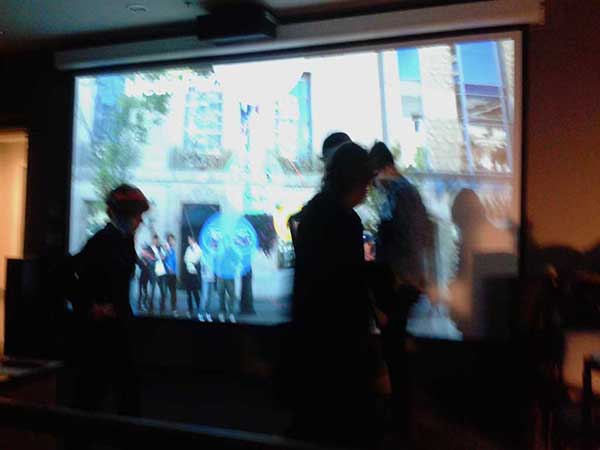
Daniel and I often collaborate but we do individual projects as well.
Last July we were Artists in Residence in the Everglades. Invited there by the AIRIE Program and the U.S. National Park Service, we carried out research for our FLOW: BIG WATERS project. Upon returning to Canada, we began by polishing poetry and prose texts that we had started writing while on site. From that we have produced a series of videos, and continue to work on developing soundwalks for specific locations within the Everglades National Park. We will be printing photographs from some of the material we brought back and when complete, the work will be shown in installation.
We were invited to Miami in November to screen some of these videos at the Miami Book Fair International. We also participated in a panel discussion on links between art and science, as well as the transformative experience of spending time in the Everglades.
In connection with the University of Miami’s AnthropoScene: Art and Nature in a Manufactured Era, we will be going back to Miami in March to screen videos in an exhibition on campus. During our visit, we will be giving a workshop.

Miami Report – Valerie LeBlanc and Daniel Dugas (2014)
Report from a visit to Miami and the Everglades National Park – Valerie LeBlanc and Daniel Dugas, November 2014
Our visit to South Florida to screen video poetry at the Miami Book Fair International and a visit to the Everglades National Park was short. Aside from the two days of air travel, we were there for just three days, really full days! To begin, on November 18, we screened several videos and took part in a panel discussion on the transformative effects that the July 2014 AIRIE (Artist In Residence In Everglades) residency had on our work. While our FLOW: BIG WATERS everglades-based project is ongoing and will eventually include an installation with soundwalks and photographs, we were happy to screen a selection of the video works that we have completed to this date.
The panel discussion was co-moderated by Artist and AIRIE Executive President, Deborah Mitchell and Biologist Skip Snow. The five AIRIE Artists who presented and took part in the discussion were: Gustavo Matamoros, Reed van Brunschot, Author Anne McCrary Sullivan, and ourselves. After brief introductions by Deborah Mitchell, Miami historian Dr. Paul George opened the conversation with details about the current and recent landmarks that stand and stood close to the Book Fair venue we were sitting within. Downtown Miami is undergoing many physical changes as new buildings replace older structures. Dr. George’s comments brought some of these changes to light. The evening took place at the SWAMP; the pop-up lounge utilized for showcasing social and cultural events during the Miami Book Fair International on the Miami Dade College, Wolfson Campus.
After the AIRIE presentation, Gustavo Matamoros and his partner, Miami-based Graphic Artist Claudia Ariano invited us to drive over to Little Havana’s El Cristo Restaurant to experience Cuban cuisine. The conversations continued in a range of topics that ran from contemporary art through a variety of cultural markers.
During two of our days, we walked around the Wolfson Campus and Miami’s downtown to become somewhat oriented with the city. We found our way over to the Miami Beach Mall for the opening of an umbrella of exhibitions at the ArtCenter of South Florida. The open studios and exhibitions for the 30 Years on the Road show spread out from 924 Lincoln Road, along the block to transform the experience from indoor venues to vitrines for sidewalk viewing. It is an ambitious undertaking that showcases retrospective and contemporary artworks embodying many genres. Outside of 924 Lincoln, the Listening Gallery, in partnership with Subtropics.org is presenting the collaborative work: Walk-Run. On opposite sides of the entrance doors, Walk-Run features face to face moving images by Charles Recher. Combined with a soundscape by Rene Barge and Gustavo Matamoros, Walk-Run can be experienced differently depending on if you are up-close to it, on the sidewalk in front of the building, or at distance. Turning the corner to view other artworks presented in vitrines also permits variable exposure to the audio as the sound waves bend around the architecture of the cityscape. Owing to the nature of showing so many artists at one time, the opening reception moved along the block with conversations continuing inside in and outside of the studios. Walking this stretch of the Mall with Gustavo, we met and talked with many artists. We also took time to view examples of art deco along the Lincoln Road Mall.
On November 20, the final day of our visit, Deborah Mitchell invited us to drive out to the AIRIE lab to visit November’s resident artist Regina Jestrow. Regina had generously organized an open studio reception in the lab where she laid out a sampling of the research she carried out during the month. It was a chance to talk informally with Regina, the other artists and scientists who dropped by, and several of the Park Staff that we had the pleasure of working with during July. We saw the beginning stages of Regina’s artworks utilizing imprinted rubbings and look forward to seeing the next stage of this new textile based work.
Back in Miami the same evening, we visited the Locust Project. Showing in the Main Space is Daniel Arsham’s Welcome to the Future. In the project room,Salvadorian artist Simón Vega’s exhibition Sub-Tropical Social Sculptures is ongoing.We arrived in time for the Art on the Move presentation with Curator Dominic Molon in conversation with Vancouver-based artist Ron Terada. The subject of the discussion was Terada’s Soundtrack for an Exhibition.
Our on-the-ground introduction to the Miami art scene gave us the chance to scratch the surface of this diverse, multicultural city where Spanish is the predominantly spoken second language. Staying in downtown Miami gave us the chance to see the last days of the old Miami Herald Building as it underwent demolition. It will be interesting to go back and see what new masterpiece rises to replace it on Biscayne Bay. If one word could be used to describe the face and evolving culture of Miami, vibrant would fit!



This activity was supported by the New Brunswick Arts Board


And the MBFI / The Swamp

Spem reduxit / Hope restored (2014)
Key Words: New Brunswick, debt, marijuana, traffic code, zombies, marketing
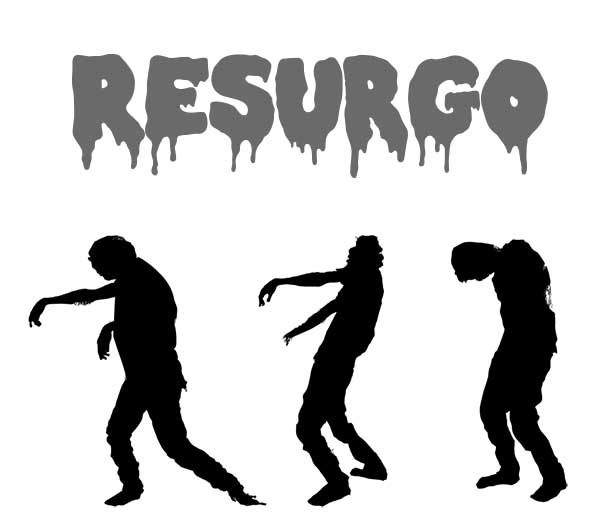
“Time to rebound is running out”, it’s a “financial disaster”[1], it’s “very concerning”[2], “our regional economy is flat-lining and we are depopulating… it’s a death spiral”[3], it’s a “perfect fiscal storm”[4] and so on. We’ve all heard the song. It’s terrible and it seems that there isn’t much we can do. We are doomed, but are we really?
Here are a few ideas, of what we might be able to do.
P as in POT
The first idea is a simple one: New Brunswick could legalize marijuana (medical and recreational). Our province has vast fields of uncultivated land, which always makes me wonder where have the farmers gone? In addition, our climate is mainly humid continental with warm summers, which is excellent for growing stuff. By decriminalizing marijuana, our province would be the first in the country, and this alone would be an incredible business opportunity.This prospect that has already created waves: in the aim of defining target markets and customers, market research professionals have begun asking Canadians what they think of marijuana. When the questions start flying, you can assume that the product is on its way. Even the Globe and Mail is writing about the future of cannabis in Canada.[5]
I like this idea because it has a two-fold potential: to generate tax revenues, and to become a fountain of youth. Legalize it and they will come. They, the young people from all over the country might consider New Brunswick as a place to live and to settle. This could be the true golden age of New Brunswick. For those who might say that marijuana falls into federal legislation (Controlled Drugs and Substances Act), I would point out that it is the provinces that control the “administration of justice.”[6] Moreover I would invoke the right to economic dignity. I believe that every province has a right to create an environment where its citizens can flourish and to deny New Brunswick the possibility of improved economic revenue would be criminal.
T as in TRAFFIC
The second idea concerns the drivers and the police departments of all towns and cities in New Brunswick. As a pedestrian I can attest to the danger of walking on our streets. There are many factors that make walking a dangerous activity: car culture, changing weather, darkness in winter, cultural misunderstanding on the meaning of yellow lights, etc. The fact is that there is a potential gold mine at every corner and maybe we should be exploiting these open pit deposits. A officer could monitor a crosswalk and give as many fines as necessary to drivers who see the flashing lights, see the pedestrians but don’t think they should slow down.
Z as in ZOMBIES
They are currently hot on TV with; Z Nation, The Returned, The Walking Dead, and of course, there are zombie walks all over the world. We are fascinated by their relentless stamina and as Angela Becerra Vidergar pointed out in a recent article “Zombies are important as a reflection of ourselves.”[7]
The question here is what can these tireless workers do for us? The motto for the city of Moncton is Resurgo, Latin for “To rise up again.” That is zombie speak and is awesome. The province should quickly seize Moncton’s motto, make it its own and market itself as a global hub for anything zombies. Here again, two birds with one stone, during the zombie walks, police could dispense tickets to zombie drivers.
Daniel Dugas
November 27 2014
[1] Richard Saillant, director general of the Canadian Institute for Research on Public Policy and Public Administration in “New Brunswick barrelling toward bankruptcy, analyst warns”, CBC News, April 29, 2014.
[2] Auditor General Kim MacPherson in “Auditor General troubled by debt growth”, CBC NEWS, Dec 05, 2013.
[3] Frank McKenna in, ‘Good governments do not allow mob rule”, The Chronicle Herald, November 4, 2014.
[4] Donald Savoie in “Paying the piper”, Atlantic Business Magazine, February 23, 2012
[5] Jeffrey Simpson, ‘Should Canada do a Uruguay on pot?’ Dec 3 2014.
See also, Jeffrey Simpson, ‘A marijuana measure worth watching‘. Dec 5, 2014.
[6] Sensible BC, Canada’s largest marijuana reform group in Frequently Asked Questions.
[7] Angela Becerra Vidergar in “Stanford scholar explains why zombie fascination is very much alive“, Stanford Report, February 20, 2013.
Zombie Silhouettes by SymbiopticStudios
Spem reduxit / Hope restored is New Brunswick ‘s motto
Click here to read part 1: Home of the New Balance: Nota bene published on August 26 2014.
Daniel H. Dugas
Archives
Blogroll
- A.I.R. Vallauris
- ACAD
- Adobe additional services
- Adobe Creative Cloud
- AIRIE
- Amaas
- Amazon Author Central
- ARTothèque
- Australian Poetry
- Basic Bruegel
- Bitly
- CCCA
- CDBaby
- Cycling 74
- Dissolution
- Éditions Prise de parole
- Emmedia
- eyelevelgallery
- FAVA
- Festival acadien de poésie
- Festival FRYE Festival
- FILE – Electronic Language International Festival
- Freeware list
- Fringe Online
- Galerie Sans Nom
- Gotta Minute Film Festival
- Instants Vidéo
- JUiCYHEADS
- Kindle Direct Publishing
- Klondike Institute of Art and Culture
- La Maison de la poésie de Montréal
- La Maison de la Poésie et de la Langue française Wallonie-Bruxelles
- Laboratorio Arte-Alameda
- Le Centre Jacques Cartier
- Liberated Words
- Maison Internationale de la Poésie – Arthur Haulot
- MediaPackBoard
- Miami Book Fair International
- Monoskop
- Mot Dit
- NSCAD University
- Paved Arts
- PoetryFilm
- Portail des auteurs du Nouveau-Brunswick
- RECF
- Revue Ancrages
- Salon du Livre du Grand Sudbury
- Sculpture Space
- Subtropics.org
- Sydney college for the arts
- The Centre for Contemporary Canadian Art
- The New Gallery
- Trevigliopoesia
- tumbler-documents
- V Tape
- Valerie LeBlanc
- VideoBardo
- Void Network-Κενο Δίκτυο
Categories
- #covidpoèmes
- Advertisement
- AIRIE
- Ancrages
- anthology
- Anthropocene
- Architecture
- Around Osprey
- art
- Article de presse
- arts visuels
- audio
- Australian Poetry
- Basic Bruegel Editions
- Book
- book fair
- Cafe Poet Program
- Ce qu'on emporte avec nous
- Citations gratuites
- Collaboration
- commentaire
- commentary
- Compte rendu
- conférence
- Conservation Foundation of the Gulf Coast
- COVID-19
- Critique littéraire
- culture
- Daniel Dugas
- Design
- Édition Michel-Henri
- Éditions Perce-Neige
- Éloizes
- Emmedia
- emoji etc | émoji etc
- Environnement
- essai
- essay
- Everglades
- Exhibition
- festival
- Festival acadien de poésie
- Festival Frye Festival
- FIPTR
- Flow: Big Waters
- Fundy
- Habitat
- installation
- Instants Vidéo
- interactivity
- journal
- JUiCYHEADS
- Kisii
- L'Esprit du temps
- laptop
- Leaving São Paulo
- lecture
- Livre
- logos
- Magazine
- Miami Book Fair
- Moncton 24
- novel
- OASIS
- oil spill
- perception
- performance
- Photo
- poésie
- Poetic Licence Week
- Poetry
- politics
- politique
- press
- Prise de parole
- Revue Ancrages
- salon du livre
- sculpture
- Sculpture Space
- sound
- Souvenirs
- Spirit of the Time
- Style & Artifacts
- Symposium d'art/nature
- talk
- television
- The New Gallery
- Uncategorized
- Valerie LeBlanc
- vidéo
- vidéopoésie
- Videopoetr/Vidéopoésie
- videopoetry
- visual arts
- What We Take With Us
- youth literature






